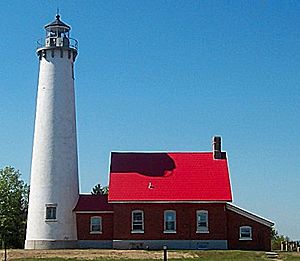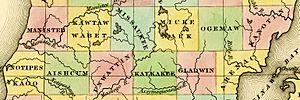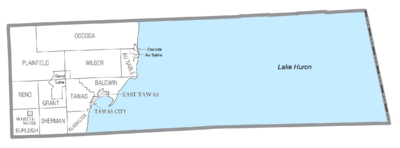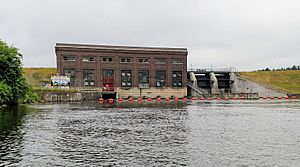Iosco County, Michigan facts for kids
Quick facts for kids
Iosco County
|
||
|---|---|---|

|
||
|
||

Location within the U.S. state of Michigan
|
||
 Michigan's location within the U.S. |
||
| Country | ||
| State | ||
| Founded | 1840 (as "Kanotin") 1857 organized |
|
| Seat | Tawas City | |
| Largest city | East Tawas | |
| Area | ||
| • Total | 1,890 sq mi (4,900 km2) | |
| • Land | 549 sq mi (1,420 km2) | |
| • Water | 1,341 sq mi (3,470 km2) 71%% | |
| Population
(2020)
|
||
| • Total | 25,237 | |
| • Density | 47/sq mi (18/km2) | |
| Time zone | UTC−5 (Eastern) | |
| • Summer (DST) | UTC−4 (EDT) | |
| Congressional district | 1st | |
Iosco County (/aɪˈɒskoʊ/ eye-OSS-koh) is a county in the U.S. state of Michigan; its eastern border is formed by Lake Huron. As of the 2020 census, its population was 25,237. Its seat of government is Tawas City.
Contents
Etymology
Iosco has traditionally been said to be a Native American word meaning "water of light", but was actually coined as a pseudo-Native American name by Henry Rowe Schoolcraft, an American geographer and ethnologist who served as the U.S. Indian agent in Michigan in the late 19th century. He named several counties and towns during the state's formative years.
History

The county was created by the Michigan Legislature in 1840 as Kanotin County, and renamed Iosco County in 1843. It was administered by a succession of other Michigan counties before the organization of county government in 1857. A majority of the population was Ojibwe. The area offered shelter from tall white pines and food from the river and lake. Iosco County was cut from a piece of land ceded by the Ojibwe to the U.S. government. When the lumber boom hit, many more people moved to the area.
The 400-acre Alabaster Historic District, listed on the National Register of Historic Places, is associated with an operating gypsum open-pit mine south of Tawas City. The large company town included internal rail lines for transportation and a tramway extending over Lake Huron on long piers for loading gypsum onto ships. Started in 1862, the mine supplied gypsum for temporary buildings constructed in Chicago at the World Columbian Exposition of 1893. Two companies continue to mine gypsum in Iosco County.
In 2009, Alabaster Township formed the nonprofit Alabaster Wind Power Development Corp. to conduct the necessary two-year studies of wind data at this site as a potential location for development of wind turbines. It proposed using 10 large tramway platforms that extend more than 6,000 feet into the lake to gauge winds. The turbines could be built on the tramways. At the time, the federal government was offering subsidies for such studies and development of alternative energy projects.
Geography
According to the US Census Bureau, the county has an area of 1,890 square miles (4,900 km2), of which 549 square miles (1,420 km2) is land and 1,341 square miles (3,470 km2) (71%) is water. It is considered part of Northern Michigan. In total, it covers about 6,361,837 acres.
Geographic features
- Lumberman's Monument
- Canoer's memorial
- 60 Lakes Area - Located near Hale
- Iargo Springs
- Tawas Point Light House - First lit in 1853
- Tawas Bay
- Pine River – rises in Alcona County and flows into Iosco County, where it empties into Van Etten Lake at 44°29′38″N 83°23′16″W / 44.49389°N 83.38778°W northwest of Oscoda.
- Au Sable River
- Tuttle Marsh Wildlife Area
- Van Etten Lake
- Tawas Lake
- Foote Dam Pond
- Au Sable State Forest (partial) – the Grayling Fire Management Unit consists of Alcona, Crawford, and Oscoda Counties, and northern Iosco county.
Major highways
 US 23 – known as the Sunrise Side Coastal Highway.
US 23 – known as the Sunrise Side Coastal Highway. M-55 – one of three cross-peninsular state highways. It begins in Tawas City at the junction with US 23.
M-55 – one of three cross-peninsular state highways. It begins in Tawas City at the junction with US 23. M-65
M-65 F-41
F-41- River Road National Scenic Byway – starts at M-65 and runs parallel with the Au Sable River for 23 miles (37 km) eastward to US 23 in Oscoda, Michigan. It is a designated National Scenic Byway. It passes the Lumberman's Monument.
Adjacent counties
By land
- Alcona County - north
- Arenac County - southwest
- Ogemaw County - west
- Oscoda County - northwest
By water
- Huron County - southeast
National protected area
- Huron National Forest (part)
Communities

Cities
- East Tawas
- Tawas City (county seat)
- Whittemore
Charter townships
- Au Sable Charter Township
- Oscoda Charter Township
Civil townships
- Alabaster Township
- Baldwin Township
- Burleigh Township
- Grant Township
- Plainfield Township
- Reno Township
- Sherman Township
- Tawas Township
- Wilber Township
Census-designated places
Other unincorporated communities
- Alabaster
- Foote Site Village
- Hale
- Long Lake
- National City
- South Branch
Demographics
| Historical population | |||
|---|---|---|---|
| Census | Pop. | %± | |
| 1860 | 175 | — | |
| 1870 | 3,163 | 1,707.4% | |
| 1880 | 6,873 | 117.3% | |
| 1890 | 15,224 | 121.5% | |
| 1900 | 10,246 | −32.7% | |
| 1910 | 9,753 | −4.8% | |
| 1920 | 8,199 | −15.9% | |
| 1930 | 7,517 | −8.3% | |
| 1940 | 8,560 | 13.9% | |
| 1950 | 10,906 | 27.4% | |
| 1960 | 16,505 | 51.3% | |
| 1970 | 24,905 | 50.9% | |
| 1980 | 28,349 | 13.8% | |
| 1990 | 30,209 | 6.6% | |
| 2000 | 27,339 | −9.5% | |
| 2010 | 25,887 | −5.3% | |
| 2020 | 25,237 | −2.5% | |
| 2023 (est.) | 25,373 | −2.0% | |
| US Decennial Census 1790-1960 1900-1990 1990-2000 2010-2018 |
|||
As of the 2000 United States census, there were 27,339 people, 11,727 households, and 7,857 families in the county. Most of the population is located on the shoreline along US-23, East Tawas, Tawas City, and Oscoda County. The population density was 50 people per square mile (19 people/km2). There were 20,432 housing units at an average density of 37 per square mile (14/km2). By the 2020 census, its population was 25,237.
In 2000, the county's racial makeup was 96.92% White, 0.41% Black or African American, 0.66% Native American, 0.46% Asian, 0.05% Pacific Islander, 0.23% from other races, and 1.27% from two or more races. 0.98% of the population were Hispanic or Latino of any race. 23.2% were of German, 12.3% English, 10.6% Irish, 9.9% American, 8.3% Polish and 7.1% French ancestry. 97.4% spoke English and 1.0% Spanish as their first language.
There were 11,727 households, out of which 24.90% had children under the age of 18 living with them, 55.20% were married couples living together, 8.40% had a female householder with no husband present, and 33.00% were non-families. 28.60% of all households were made up of individuals, and 14.00% had someone living alone who was 65 years of age or older. The average household size was 2.30 and the average family size was 2.79.
The county population included 22.40% under the age of 18, 5.40% from 18 to 24, 23.40% from 25 to 44, 27.30% from 45 to 64, and 21.60% who were 65 years of age or older. The median age was 44 years. For every 100 females there were 96.30 males. For every 100 females age 18 and over, there were 93.60 males.
In 2000, the median income for a household in the county was $31,321, and the median income for a family was $37,452. Males had a median income of $30,338 versus $21,149 for females. The per capita income for the county was $17,115. About 9.50% of families and 12.70% of the population were below the poverty line, including 18.50% of those under age 18 and 7.60% of those age 65 or over.
Education
Iosco County has four public school districts:
- Hale Area Schools
- Oscoda Area Schools
- Tawas Area Schools
- Whittemore-Prescott Area Schools
There are also three private elementary schools:
- Emanuel Lutheran School (Tawas City)
- Holy Family School (East Tawas)
- Shady Grove School (Whittemore)
Alpena Community College offers college-level courses at its campus on the former Wurtsmith Air Force Base in Oscoda and local public school facilities.
Media
- The Iosco County News-Herald is the newspaper of record for Iosco County.
- The Oscoda Press is a weekly newspaper serving northern Iosco County and southern Alcona County.
See also
 In Spanish: Condado de Iosco para niños
In Spanish: Condado de Iosco para niños



